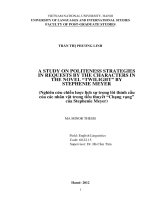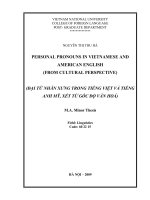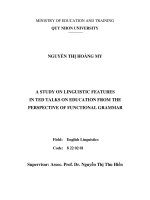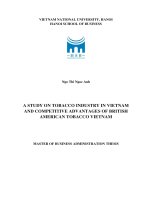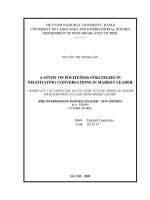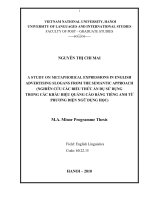(Luận văn thạc sĩ) a study on the influence of japanese manga and anime on primary schoolers in hai phong city
Bạn đang xem bản rút gọn của tài liệu. Xem và tải ngay bản đầy đủ của tài liệu tại đây (976.36 KB, 46 trang )
BỘ GIÁO DỤC VÀ ĐÀO TẠO
TRƯỜNG ĐẠI HỌC DÂN LẬP HẢI PHỊNG
-------------------------------
ISO 9001:2015
KHĨA LUẬN TỐT NGHIỆP
NGÀNH: NGƠN NGỮ ANH – NHẬT
Sinh viên
: Lương Phú Cường
Giảng viên hướng dẫn : Th.s Khổng Thị Hồng Lê
HẢI PHÒNG - 2019
MINISTRY OF EDUCATION AND TRANING
HAIPHONG PRIVATE UNIVERSITY
-----------------------------------
A STUDY ON THE INFLUENCE OF JAPANESE MANGA
AND ANIME ON PRIMARY SCHOOLERS IN HAIPHONG
CITY
GRADUATION PAPER
Student
Class
Supervisor
: Luong Phu Cuong
: NA1901N
: Khong Thi Hong Le, M.A
HAI PHONG - 2019
BỘ GIÁO DỤC VÀ ĐÀO TẠO
TRƯỜNG ĐẠI HỌC DÂN LẬP HẢI PHÒNG
--------------------------------------
NHIỆM VỤ ĐỀ TÀI TỐT NGHIỆP
Sinh viên: Lương Phú Cường
Lớp: NA1901N
Mã SV: 1512753028
Ngành: Ngôn ngữ Anh - Nhật
Tên đề tài: A study on the influence of Japanese manga and anime on
primary schoolers in Hai Phong city
NHIỆM VỤ ĐỀ TÀI
1. Nội dung và các yêu cầu cần giải quyết trong nhiệm vụ đề tài tốt nghiệp
( về lý luận, thực tiễn, các số liệu cần tính toán và các bản vẽ).
A study on the influence of Japanese manga and anime on primary
schoolers in Hai Phong city
2. Các số liệu cần thiết để thiết kế, tính tốn.
……………………………………………………………………………..
……………………………………………………………………………..
……………………………………………………………………………..
……………………………………………………………………………..
……………………………………………………………………………..
……………………………………………………………………………..
……………………………………………………………………………..
……………………………………………………………………………..
……………………………………………………………………………..
3. Địa điểm thực tập tốt nghiệp.
Công ty TNHH Dịch Thuật Quốc Tế Hải Phòng
CÁN BỘ HƯỚNG DẪN ĐỀ TÀI TỐT NGHIỆP
Người hướng dẫn thứ nhất:
Họ và tên: Khổng Thị Hồng Lê
Học hàm, học vị: Thạc sĩ
Cơ quan công tác: Đại học Dân lập Hải Phòng
Nội dung hướng dẫn: A study on the influence of manga and anime on
primary schoolers in Haiphong city
Người hướng dẫn thứ hai:
Họ và tên:.............................................................................................
Học hàm, học vị:...................................................................................
Cơ quan công tác:.................................................................................
Nội dung hướng dẫn:............................................................................
Đề tài tốt nghiệp được giao ngày 01 tháng 07 năm 2019
Yêu cầu phải hoàn thành xong trước ngày 21 tháng 9 năm 2019
Đã nhận nhiệm vụ ĐTTN
Đã giao nhiệm vụ ĐTTN
Sinh viên
Người hướng dẫn
Hải Phòng, ngày ...... tháng........năm 2019
Hiệu trưởng
GS.TS.NGƯT Trần Hữu Nghị
CỘNG HÒA XÃ HỘI CHỦ NGHĨA VIỆT NAM
Độc lập - Tự do - Hạnh phúc
PHIẾU NHẬN XÉT CỦA GIẢNG VIÊN HƯỚNG DẪN TỐT NGHIỆP
Họ và tên giảng viên: ...................................................................................................
Đơn vị công tác:
........................................................................ ..........................
Họ và tên sinh viên:
.......................................... Chuyên ngành: ...............................
Đề tài tốt nghiệp:
...................................................................................................
........................................................... ........................................
Nội dung hướng dẫn:
.......................................................... ........................................
............................................................................................................................
Tinh thần thái độ của sinh viên trong quá trình làm đề tài tốt nghiệp
......................................................................................................................................
..............................................................................................................................................
..............................................................................................................................................
..............................................................................................................................................
..............................................................................................................................................
..............................................................................................................................................
1. Đánh giá chất lượng của đồ án/khóa luận (so với nội dung yêu cầu đã đề ra
trong nhiệm vụ Đ.T. T.N trên các mặt lý luận, thực tiễn, tính tốn số liệu…)
..............................................................................................................................................
..............................................................................................................................................
..............................................................................................................................................
..............................................................................................................................................
..............................................................................................................................................
3. Ý kiến của giảng viên hướng dẫn tốt nghiệp
Được bảo vệ
Không được bảo vệ
Điểm hướng dẫn
Hải Phòng, ngày … tháng … năm ......
Giảng viên hướng dẫn
(Ký và ghi rõ họ tên)
CỘNG HÒA XÃ HỘI CHỦ NGHĨA VIỆT NAM
Độc lập - Tự do - Hạnh phúc
PHIẾU NHẬN XÉT CỦA GIẢNG VIÊN CHẤM PHẢN BIỆN
Họ và tên giảng viên:
..............................................................................................
Đơn vị công tác:
........................................................................ .....................
Họ và tên sinh viên:
...................................... Chuyên ngành: ..............................
Đề tài tốt nghiệp:
......................................................................... ....................
............................................................................................................................
............................................................................................................................
1. Phần nhận xét của giáo viên chấm phản biện
..........................................................................................................................................
..........................................................................................................................................
..........................................................................................................................................
..........................................................................................................................................
..........................................................................................................................................
..........................................................................................................................................
..........................................................................................................................................
2. Những mặt còn hạn chế
.........................................................................................................................................
.......................................................................................................................................
..........................................................................................................................................
..........................................................................................................................................
..........................................................................................................................................
..........................................................................................................................................
..........................................................................................................................................
3. Ý kiến của giảng viên chấm phản biện
Được bảo vệ
Không được bảo vệ
Điểm phản biện
Hải Phòng, ngày … tháng … năm ......
Giảng viên chấm phản biện
(Ký và ghi rõ họ tên)
ACKNOWLEDGEMENT
In the process of doing the graduation paper, I have received a lot of help,
assistance, guidance and encouragement from my teachers, family and friends.
First and foremost, I would like to express my deepest gratitude to my
supervisor Ms. Khong Thi Hong Le, M.A, the lecturer of foreign language
faculty, Haiphong Private University, for her whole-hearted guidance and
support. Without her invaluable recommendations and advice, I could not finish
this thesis.
My sincere thanks are also sent to all the teachers of English department
at Haiphong Private University for their precious and useful lessons during my
four year study which have been then the foundation of this research paper.
Last but not least, I would like to give my heartfelt thanks to my family,
my friends who always encourage and inspire me to complete this graduation
paper.
Hai Phong, September 2019
Luong Phu Cuong
i
TABLE OF CONTENTS
Acknowledgment .................................................................................................. i
Table of contents.................................................................................................. ii
List of abbreviations........................................................................................... iii
List of tables ....................................................................................................... iiii
Part 1: Introduction
1.1.
Rationale..........................................................................................1
1.2.
Aims of the study.............................................................................2
1.3.
Methods of the study.......................................................................2
1.4.
Scope of the study............................................................................3
1.5.
Design of the study..........................................................................3
Part 2: Development
Chapter 1: Literature Review............................................................................4
1.1. Overview of Japanese manga and anime..................................................4
1.1.1.
General theoretic issues about manga and anime........................4
1.1.1.1. Notions..........................................................................................4
1.1.1.2. Trait and role of Japanese manga and anime..........................5
1.2. Generic manga and anime of Japanese.....................................................7
1.2.1. Japanese manga and anime industry................................................7
1.2.2. The influence of Japanese manga and anime on international
market..................................................................................................9
1.3. Real situation of publishing, consuming Japanese manga and watching
anime on the internet in Hai Phong.........................................................13
1.3.1. Real situation of publishing and consuming Japanese manga in
HP.......................................................................................................13
1.3.2. Real situation of watching anime on the internet in HP................13
Chapter 2: Methodology...................................................................................14
2.1. Participants................................................................................................14
2.2. Instrument..................................................................................................14
2.3. Data collection and analysis......................................................................14
ii
Chapter 3: Findings and discussion.................................................................15
3.1. Primary schoolers’s popularity of reading manga and watching
anime...........................................................................................................15
3.2. Primary schoolers’s frequency of reading manga and watching
anime...........................................................................................................16
3.3. Types of reading manga and watching anime........................................17
3.4. Ways of reading manga and watching anime.........................................18
3.5. Locations for reading manga and watching anime................................19
3.6. Students’ feelings about read manga and watch anime.........................20
Chapter 4: Comments and solutions to the impact of Japanese manga and
anime on primary schoolers in HP..................................................................22
4.1. The impacts of Japanese manga and anime on primary schoolers in
HP...............................................................................................................22
4.1.1. The positive impact...........................................................................22
4.1.2. The negative impact..........................................................................26
4.2. Solutions to the impact of Japanese manga and anime on primary
schoolers in HP..........................................................................................27
4.2.1. Solutions to management agencies...................................................27
4.2.2. Solutions to publishers and manufacturers....................................28
4.2.3. Solutions to family.............................................................................28
4.2.4. Solutions to primary schoolers.........................................................28
Part 3: Conclusion
1.
Summary..................................................................................................29
2.
Limitations...............................................................................................29
3.
Recommendations for further study.....................................................30
References..........................................................................................................31
Appendix............................................................................................................32
iii
LIST OF ABBREVIATIONS
Fig.1
Figure 1
Fig.2
Figure 2
GDP
Gross Domestic Product
HP
Hai Phong
U.S.
United States
iv
LIST OF FIGURES
Figure 1
The Japanese Animation Market in a Broad Sense(Yen in billions)
Figure 2
The Domestic and Overseas Revenues of Japanese Animation
Industry in a Broad Sense(Yen in billions)
Figure 3
The popularity of Japanese manga and anime
Figure 4
The frequency of reading manga and watching anime
Figure 5
Types of manga and anime the children likes
Figure 6
Ways of reading manga and watching anime
Figure 7
Locations for reading manga and watching anime
Figure 8
Students’s feeling about the influence of manga and anime
v
PART I
INTRODUCTION
1.1.
Rationale
There is no denying that children are always considered as the first stage of
human life. It’s the stage to equip children with the necessary qualities and
ability to paricipate in their later social life. This is a period of personality
formation for children, forming personal needs, hobbies, thoughts and gender
awareness by the influence of the children’s daily contact with their surrounding
environment. Creating good and healthy habits that is appropriate to the age of
children will positively impact the overall development of children later. Two of
the habits which have a profound effect on the development of thinking,
morality, lifestyle, behavior..., are reading books and watching films.
Today in our contemparory society, parents always encourage the children to
read books and watch films. As a matter of fact, most children usually choose
jokes, comics or cartoon films to entertain themselves after stressful and tiring
lessons. This is also a source of information to learn new knowledge in addition
to media and books in schools. With the strong explosion of information
technology, audiovisual culture has significantly affected the reading habits of
children. Beside the stories, today children can easily access online comics and
films with technology devices when there is an internet connection. It is the
reason for Japanese manga and anime to enter Viet Nam.
Manga and anime are known as one of the cultural values which is very typical
of Japan. Japanese manga and anime has been present in many countries around
the world and contributed to the “Japanese cultural phenomenon”. In Viet Nam,
Japanese manga and anime has strongly influenced many young generations
during the past 22 years. With readable, understandable, nice images and
interesting stories, Japanese manga and anime has created irresistible attraction
for Vietnamese children in general and children in Hai Phong in particular.
There are a lot of Japanese manga and anime which bring human values,
positive educational elements to children. However, Japanese manga and anime
in Viet Nam are having a booming phenomenon and uncontrollableness, leading
to negative effects on children.
1
For these reasons, I conduct a study on “The influence of Japanese manga and
anime on primary schoolers in Hai Phong city” with an expectation to look for
impacts of Japanese manga and anime on students in primary schools in Hai
Phong city as well as solutions to minimise their negative effects.
1.2.
Aims of the study
This study aims at analyzing the influence of Japanese manga and anime on
primary schoolers in Hai Phong city and giving solutions to develop active
effect and limit their negative effect.
Two research questions were addressed as follow:
What are the influences of Japanese manga and anime on primary
schoolers in Hai Phong city?
What are the solutions to Japanese manga and anime’s impact on
primary schoolers in Hai Phong city?
1.3.
Methods of the study
In order to complete this study, the following methods were employed:
Analytic and synthetic methods
Survey methods
Interview methods
First, the study took full advantage of analytic and synthetic methods to review
all the theories related to the matter from various reliable sources to create the
framework for the data analysis.
Second, survey methods were used to gather data of the primary schoolers to
have an overview and the most accurate view of the current situation.
Third, interview methods were used to add several information from schoolers’
parents and bosses of book stores.
2
1.4.
Scope of the study
Studying the influence of Japanese manga and anime on primary schoolers is
immense, so the study can not cover all students in primary schoolers in Hai
Phong city. Therefore, my study was mainly carried out in Dong Hai Primary
school where I used to study.
1.5.
Design of the study
This study is composed of three main parts:
Part 1 is the introduction which consists of rationale, aims, study
methods, the scope and design of the study.
Part 2 is the development- the main part of this paper which is
divided into four chapters :
- Chapter one is theoretical background of Japanese manga and anime.
- Chapter two shows detailed explanation of the methodology.
- Chapter three indicates real situation and the influence of Japanese manga
and anime on primary schoolers in Hai Phong city.
- Chapter four is comments and solutions to the impact of Japanese manga
and anime on primary schoolers in Hai Phong city.
Part 3 is the conclusion which summarizes what was given in
previous parts.
3
PART II
DEVELOPMENT
Chapter 1: Literature Review
1.1. Overview of Japanese manga and anime
1.1.1. General theoretic issues about manga and anime
1.1.1.1. Notions
According to Wikipedia, Manga is a kind of comics or graphic novels created in
Japan or by creators in Japanese language, conforming to a style developed in
Japan in the late 19th century. They have a long and complex pre-history in
earlier Japanese art.
The term “manga” in Japan is a word used to refer to both comics and
cartooning. “Manga” as a term used outside Japan refers to comics originally
published in Japan.
But Simon (2003) is considered that “Manga, in Japanese, means "flowing
words" or "Undisciplined words". It is an ancient art that has been used for
centuries as a form of entertainment. It's basicallt Japanese comic books, which
can be easily translated to English.”
And Cataphract (2004) is thought that “Manga is to Anime what Comics is to
Cartoons”
Anime is hand-drawn and computer animation originating from or associated
with Japan.
The word anime is the Japanese term for animation, which means all forms of
animated media. Outside Japan, anime refers specifically to animation from
Japan or as a Japanese-disseminated animation style often characterized by
colorful graphics, vibrant characters and fantastical themes. The culturally
abstract approach to the word’s meaning may open up the possibility of anime
produced in countries other than Japan. For simplicity, many Westerners strictly
view anime as a Japanese animation product. Some scholars suggest defining
anime as specifically or quintessentially Japanese may be related to a new form
of orientalism.
Brad Stephenson (2019) is considered that “Anime is a word used by people
living outside of Japan to describe cartoons or animation produced within Japan.
Using the word in English conversation is essentially the same as describing
something as a Japanese cartoon series or an animated movie or show from
Japan”.
4
1.1.1.2. Trait and roles of Japanese manga and anime
Manga history begins very early. In Japan, people soon became intersted in an
art of picture (later manga). Manga of this period was still simply short comic
strips. However, its entertainment value is something no one can deny. Not only
that, the manga also holds an important throughout the history of Japanese art.
Around the middle of the 6th and 7th centuries, monks used parchment rolls
carved as a calendar for tracking time. These scrolls which include symbolic
symbols that represent time, are often decorated with animal images such as
foxes, pandas, ... with the same movements as people (known as animal
characters of animals). The painting, or more precisely, the Choju-jinbutsu-giga
is a delight in animals and humans. This can be considered a premise of Manga.
Kordic, Pereira and Martinique wrote “During the Edo Period (1603-1867),
another book of drawings, Toba Ehon, embedded the concept of manga, yet the
term itself was first used in 1798, to describe the picture book Shiji no Yukikai
(Four Seasons) by Santou Kyouden. In 1814, it showed up again, as the title of
Aikawa Mina’s Manga hyakujo and the celebrated Hokusai Manga books of
drawings by the famous ukiyo-e artist Hokusai”.
The term Manga was perfected by Hokusai artist (this is not a real name), a
painter living with a painting philosophy is completely different from this art at
the time. With a rebellious personality, Hokusai is known for being willing to
argue with his teacher, constantly challenging their working methods. Later, he
created about 30,000 works, some of which focused on anthologies or published
books.
According to Hokusai, “manga” is not the art of drawing characters in a certain
story, or is meticulously paying attention to every detail so that it can create
entertaining and meaningful paintings. Instead, the term “manga” (which
literally translates as “bizarre painting”) was used by Hokusai to show how to
draw a pen-based picture or draw some materials across the page full of
improvisation (this explains the word “bizarre”). Although most of them become
landscape patintings, Japanese people recognize and hide in those natural but
very detailed natural drawings, something different from the previous paintings,
when painters must be aware of what they want to draw before putting down
their pens. Hokusai’s natural approach to the problem, although he himself may
not have realized it, has become the basis for the diversity of present manga-ka:
they are not tied to a recipe. Which always follow different types of characters,
5
and different storylines. However, even though Hokusai had made a new
breakthrough with this style of painting (one of the styles he used), the first true
“manga” stories had not appeared until the very beginning 20th century.
Entering the 20th century, the door of Japanese diplomacy once again opened to
the world. One of them, the "short comic strips" was also introduced, becoming
the catalyst for making manga, a dominant part of the current Japanese
publishing market. Manga of this period was called Ponchi-e. Japan began
publishing magazines with caricatures with a thickness of 1-4 pages, and hired
foreign artists to teach their students about lines, colors, and shapes.
During the war, Japanese comics and caricatures were created to serve many
different purposes. They have humor, entertainment, as well as Western stories,
but at the same time they are also used for the purpose of propagating or
sarcasm in service of national interests, encouraging the morale of soldiers.
However, under heavy defeat at the hands of the Allies at the end of World War
II, many Japanese comics were subject to heavy censorship by the victors, and
the development of what would become "manga "Japan seems to be postponed
indefinitely.
Fortunately, after the war ended, there was a person who stood up to revive the
manga art scene, brought to Japanese culture and came to the world, a
completely new genre of manga. That person, Osamu Tezuka (with the
application of Disney's cartoon style and German and French cinematography)
helped shape the first true manga model, and started an industry that up to now
retains a strategic position in modern Japanese culture.
Besides, the earliest commercial Japanese animation dated to 1917, and
Japanese anime production has since continued to increase steadily. The
characteristic anime art style emerged in the 1960s with the works of Osamu
Tezuka and spread internationally in the late twentieth century, developing a
large domestic and international audience. Anime is distributed theatrically, by
way of television broadcasts, directly to home media, and over the Internet. It is
classified into numerous genres targeting diverse broad and niche audiences.
Anime is a diverse art form with distinctive production methods and techniques
that have been adapted over time in response to emergent technologies. It
combines graphic art, characterization, cinematography, and other forms of
imaginative and individualistic techniques. The production of anime focuses less
6
on the animation of movement and more on the realism of settings as well as the
use of camera effects, including panning, zooming, and angle shots. Being handdrawn, anime is separated from reality by a crucial gap of fiction that provides
an ideal path for escapism that audiences can immerse themselves into with
relative ease. Diverse art styles are used and character proportions and features
can be quite varied, including characteristically large emotive or realistically
sized eyes.
Oliver, K wrote “Japanese anime and comics are the key to unlocking the minds
of the younger generation”. It not only helps the younger generation learn
Japanese culture, but also changes the Japanese-style lifestyle.
1.2. Generic manga and anime of Japanese
1.2.1. Japanese manga and anime industry
Hays, J (2009) researched about Manga industry in Japan. He confirmed that
manga sales now account for a third of the book and magazine market in Japan,
which translates to about $10 billion in annual sales. About two billion manga
are sold every year (40 percent of all books and magazines in Japan).
Successfull manga are usually made into animated television shows or films,
which are very popular in Japan and have a growing cult audience in the United
States and Europe. They also generate video games, games, collection cards, and
characters goods. The character goods market alone is worth $3.5 billion.
In 2007, the sale of manga books and magazines stood at around ¥470
billion.Most years about 20 to 30 percent of television dramas are derived from
manga.
According to a research of Hiromichi Masuda: “The market recorded 108.0%
growth and the highest sales in 2017, finally crossing the 2 trillion yen mark
driven by overseas sales”.
The Japanese animation market, which hit bottom in 2009 and picked up in 2010,
recorded growth for seven consecutive years and reported its highest sales for
the fourth consecutive year. The market size finally exceeded two trillion yen,
which was 110% on a year-by-year basis. Videogram sales shrunk considerably
(84.9%), and TV (98.8%), Merchandising (97.1%), and Pachinko (95.8%) also
decreased. Meanwhile, Movie (141.4%), Music (110.5%), Internet Distribution
(109.4%), Live Entertainment (129.5%) and Overseas (131.6%) expanded.
7
Movie enjoyed strong sales thanks to the blockbuster hit movie “Your Name.”
Among those, Overseas, which recorded the largest sales, especially stood out.
The year 2017 was the first year that the Japanese animation market crossed the
2 trillion yen mark (Fig.1).
(From a report about anime industry data in 2018)
The market recorded 2 trillion 152.7 billion yen in sales, growing for 8
consecutive years, with 5 consecutive years of record-breaking high sales. To
break it down by genre, TV (100.9%), Internet Distribution (113%) and Live
Entertainment (116%) expanded while five genres (i.e. Movie (61.7%),
Videogram (97.1%), Merchandising (93.0%), Music (91.6%) and Pachinko
(95.8%)) decreased. Overseas (129.6%) showed strong growth, making up for
the decline of those five genres. The ebb and flow of respective genres have
become clear compared to when this report was first issued 10 years
ago.Compared to the survey conducted ten years ago, TV recorded 115.7%
growth, reaching its peak in 2015 and remaining steady since then. Movie
(193.4%) expanded year by year, Videogram (59.9%) declined unmistakably,
and Internet Distribution (551.0%) continued to rise dramatically.
Merchandising (87.6%) declined gradually after reaching its peak in 2014,
however, it could be assumed that the genre would have grown substantially if
the sales arising from businesses not calculated in this survey, such as
application games and other digital merchandise, had been covered (note:
physical games are already covered in Merchandising). Music (99.2%) reached
its peak in 2009 and has remained steady since then. Considering the
performance of Videogram, Music, which is a part of packaged products
businesses, has been doing miraculously well. Overseas (226.6%) shrunk
substantially after reaching its first peak in the mid 2000s. It has surged again
since 2015, becoming today’s largest genre. Pachinko (175.9%), a new genre
8
from 9 years ago, reached its peak in 2014 and has declined gradually since then.
Live Entertainment (251%), also a new genre from 4 years ago, showed a
considerable growth.
1.2.2. The influence of Japanese manga and anime on international market
By 2007, the influence of manga on international comics had grown
considerably over the past two decades. "Influence" is used here to refer to
effects on the comics markets outside Japan and to aesthetic effects on comics
artists internationally.
Traditionally, manga stories flow from top to bottom and from right to left.
Some publishers of translated manga keep to this original format. Other
publishers mirror the pages horizontally before printing the translation, changing
the reading direction to a more "Western" left to right, so as not to confuse
foreign readers or traditional comics-consumers. This practice is known as
"flipping". For the most part, criticism suggests that flipping goes against the
original intentions of the creator (for example, if a person wears a shirt that
reads "MAY" on it, and gets flipped, then the word is altered to "YAM"), who
may be ignorant of how awkward it is to read comics when the eyes must flow
through the pages and text in opposite directions, resulting in an experience
that's quite distinct from reading something that flows homogeneously. If the
translation is not adapted to the flipped artwork carefully enough it is also
possible for the text to go against the picture, such as a person referring to
something on their left in the text while pointing to their right in the graphic.
Characters shown writing with their right hands, the majority of them, would
become left-handed when a series is flipped. Flipping may also cause oddities
with familiar asymmetrical objects or layouts, such as a car being depicted with
the gas pedal on the left and the brake on the right, or a shirt with the buttons on
the wrong side, but these issues are minor when compared to the unnatural
reading flow, and some of them could be solved with an adaptation work that
goes beyond just translation and blind flipping.
Regarding Europan market, Manga has influenced European cartooning in a
way that is somewhat different from in the U.S. Broadcast anime in France and
Italy opened the European market to manga during the 1970s. French art has
borrowed from Japan since the 19th century (Japonism) and has its own highly
developed tradition of bande dessinée cartooning. In France, beginning in the
9
mid-1990s, manga has proven very popular to a wide readership, accounting for
about one-third of comics sales in France since 2004. According to the Japan
External Trade Organization, sales of manga reached $212.6 million within
France and Germany alone in 2006. France represents about 50% of the
European market and is the second worldwide market, behind Japan. Brigid
Alverson wrote: “In 2013, there were 41 publishers of manga in France and,
together with other Asian comics, manga represented around 40% of new
comics releases in the country”, surpassing Franco-Belgian comics for the first
time. Jennifer Fishbein wrote: “European publishers marketing manga translated
into French include Asuka, Casterman, Glénat, Kana, and Pika Édition, among
others. European publishers also translate manga into Dutch, German, Italian,
and other languages. In 2007, about 70% of all comics sold in Germany were
manga”. Manga publishers based in the United Kingdom include Gollancz and
Titan Books. Manga publishers from the United States have a strong marketing
presence in the United Kingdom: for example, the Tanoshimi line from Random
House.
In terms of the United States, manga made their way only gradually into U.S.
markets, first in association with anime and then independently. Some U.S. fans
became aware of manga in the 1970s and early 1980s. However, anime was
initially more accessible than manga to U.S. fans, many of whom were collegeage young people who found it easier to obtain, subtitle, and exhibit video tapes
of anime than translate, reproduce, and distribute tankoubon-style manga books.
One of the first manga translated into English and marketed in the U.S. was
Keiji Nakazawa's Barefoot Gen, an autobiographical story of the atomic
bombing of Hiroshima issued by Leonard Rifas and Educomics (1980–1982).
More manga were translated between the mid-1980s and 1990s, including Golgo
13 in 1986, Lone Wolf and Cub from First Comics in 1987, and Kamui, Area 88,
and Mai the Psychic Girl, also in 1987 and all from Viz Media-Eclipse Comics.
Others soon followed, including Akira from Marvel Comics' Epic Comics
imprint, Nausicaä of the Valley of the Wind from Viz Media, and Appleseed
from Eclipse Comics in 1988, and later Iczer-1 (Antarctic Press, 1994) and
Ippongi Bang's F-111 Bandit (Antarctic Press, 1995).
In the 1980s to the mid-1990s, Japanese animation, like Akira, Dragon Ball,
Neon Genesis Evangelion, and Pokémon, made a bigger impact on the fan
experience and in the market than manga. Schodt (1996: 318-321): “Matters
10
changed when the translator-entrepreneur Toren Smith founded Studio Proteus
in 1986. Smith and Studio Proteus acted as an agent and translator of many
Japanese manga, including Masamune Shirow's Appleseed and Kōsuke
Fujishima's Oh My Goddess!, for Dark Horse and Eros Comix, eliminating the
need for these publishers to seek their own contacts in Japan”. Simultaneously,
the Japanese publisher Shogakukan opened a U.S. market initiative with their
U.S. subsidiary Viz, enabling Viz to draw directly on Shogakukan's catalogue
and translation skills.
Japanese publishers began pursuing a U.S. market in the mid-1990s due to a
stagnation in the domestic market for manga. The U.S. manga market took an
upturn with mid-1990s anime and manga versions of Masamune Shirow's Ghost
in the Shell (translated by Frederik L. Schodt and Toren Smith) becoming very
popular among fans. An extremely successful manga and anime translated and
dubbed in English in the mid-1990s was Sailor Moon. By 1995–1998, the Sailor
Moon manga had been exported to over 23 countries, including China, Brazil,
Mexico, Australia, North America and most of Europe. In 1997, Mixx
Entertainment began publishing Sailor Moon, along with CLAMP's Magic
Knight Rayearth, Hitoshi Iwaaki's Parasyte and Tsutomu Takahashi's Ice Blade
in the monthly manga magazine MixxZine. Two years later, MixxZine was
renamed to Tokyopop before discontinuing in 2011. Mixx Entertainment, later
renamed Tokyopop, also published manga in trade paperbacks and, like Viz,
began aggressive marketing of manga to both young male and young female
demographics.
In the following years, manga became increasingly popular, and new publishers
entered the field while the established publishers greatly expanded their
catalogues. The Pokémon manga Electric Tale of Pikachu issue #1 sold over one
million copies in the United States, making it the best-selling single comic book
in the United States since 1993. By 2008, the U.S. and Canadian manga market
generated $175 million in annual sales. Simultaneously, mainstream U.S. media
began to discuss manga, with articles in The New York Times, Time magazine,
The Wall Street Journal, and Wired magazine. As of 2017, manga distributor
Viz Media is the largest publisher of graphic novels and comic books in the
United States, with a 23% share of the market. BookScan sales show that manga
is one of the fastest-growing areas of the comic book and narrative fiction
markets. From January 2019 to May 2019, the manga market grew 16%,
11
compared to the overall comic book market's 5% growth. The NPD Group noted
that, compared to other comic book readers, manga readers are younger (76%
under 30) and more diverse, including a higher female readership (16% higher
than other comic books).
Besides, The Japanese animation on international market is undeniable as seen
in the figure below.
As seen in the comparison between the domestic market size and overseas
market size (Fig.2), the overseas market’s sharp rise since 2015 almost overtook
the domestic market, while the domestic market, reaching its peak in 2014, has
declined for three consecutive years due to the decline seen in major genres,
such as Merchandising and Pachinko. If the sales arising from application games
and other digital merchandise not covered in this survey (as mentioned in the
former paragraph) were added, the domestic market would likely show an
increase. But just with the current figures, it is hard to deny that the Japanese
market relies on the sales in the overseas market. Substantial growth in the
overseas market which covers the decline in the domestic market is fully
welcomed. Yet, it is frightening that Japan greatly relies on the overseas market.
There are several risks to be concerned over,such as a sudden change of business
environment in China due to politics (such as the so-called “China Risk”) or the
distribution environment occupied by US major platforms. Actually, the
animation industry (i.e. animation studios and other related businesses) gains no
upliftment despite the record-breaking sales in the market. This may be because
animation studios and the like have few chances to obtain the benefits from sales
arising from Internet distribution and application games, which are thought to
occupy a large part of overseas sales. It is desirable both for the market and the
industry that the domestic market, which is now in transition, stabilizes soon.
12
1.3.
Real situation of publishing, consuming Japanese manga and
watching anime on the internet in Hai Phong
1.3.1. Real situation of publishing and consuming Japanese manga in HP
Nowadays, Viet Nam connected 4.0 technology so you can look for manga very
easily by electronic devices. However, it does not affect much on the printed
manga market. Printed manga market is still very eventful. Mrs. Men, the boss
of a manga store said “The manga is imported to Hai Phong every Tuesday and
Friday. With a large fan base of a young section, her store sells about 350 kinds
of story books every week”.
1.3.2. Real situation of watching anime on the internet in HP
Currently, the GDP of Hai Phong people has increased, so everyone has their
own computer, ipad or mobile phone. Besides, technology development helps us
connect the internet everywhere and everytime. We can watch anime whenever
we like. Therefore, the number of views has increased rapidly on anime websites,
which proves the fact that Japanese anime is popular and has a big appeal to
young people in Hai Phong.
13
